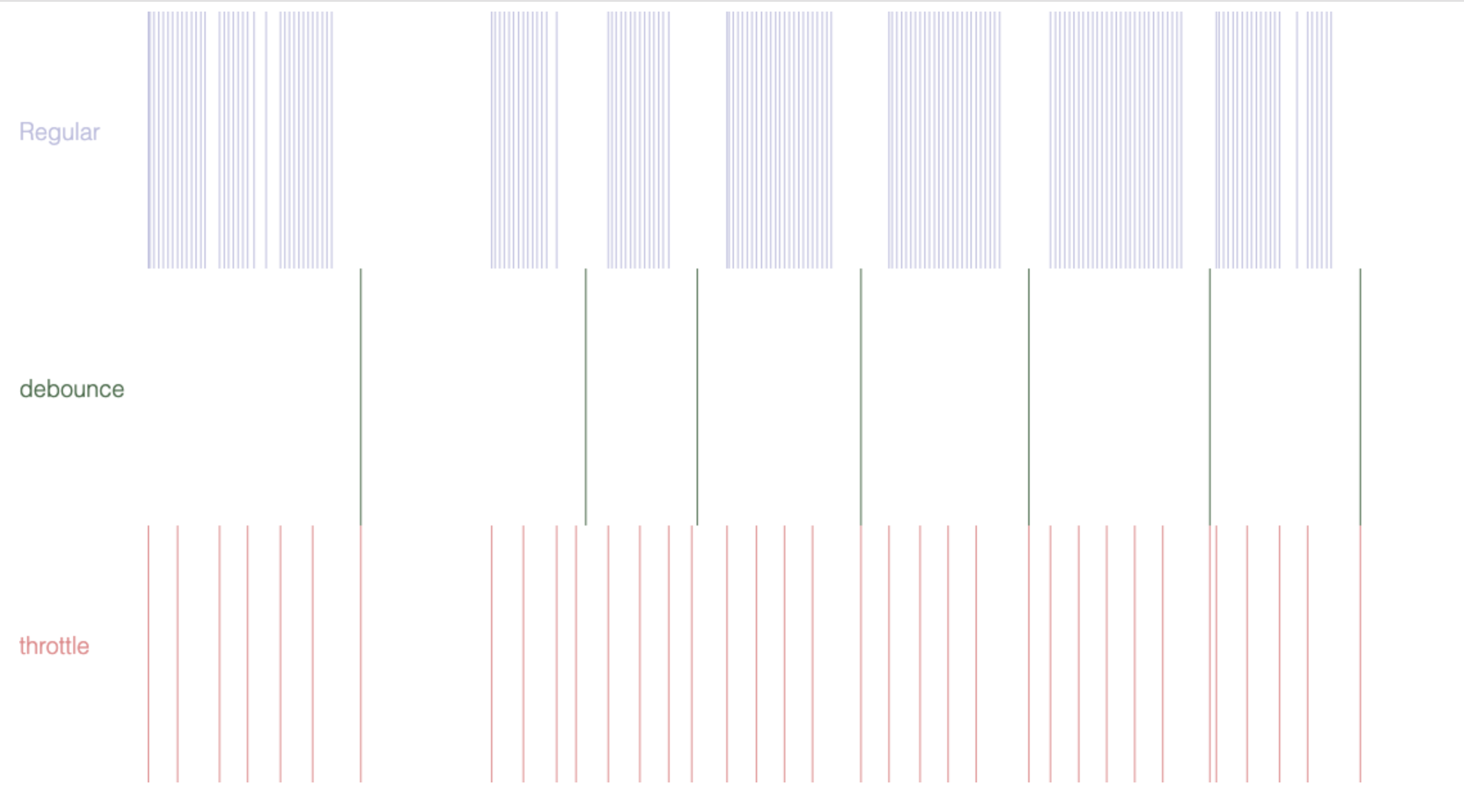限流
限流
在处理诸如 resize、scroll、mousemove 和 keydown/keyup/keypress 等事件的时候,通常我们不希望这些事件太过频繁地触发,尤其是监听程序中涉及到大量的计算或者有非常耗费资源的操作。以 mousemove 为例,根据 DOM Level 3 的规定,如果鼠标连续移动,那么浏览器就应该触发多个连续的 mousemove 事件,这意味着浏览器会在其内部计时器允许的情况下,根据用户移动鼠标的速度来触发 mousemove 事件;resize、scroll 和 key* 等事件与此类似。
debounce 会合并一组函数调用,并等待一段时间未有新的触发后执行该函数,其强制函数在某段时间内只执行一次;throttle 强制函数以固定的速率执行,并且 throttle 会保证函数的返回结果。在处理一些高频率触发的 DOM 事件的时候,它们都能极大提高用户体验。


Debounce
DOM 事件里的 debounce 概念其实是从机械开关和继电器的“去弹跳”(debounce)衍生 出来的,基本思路就是把多个信号合并为一个信号。在 JavaScript 中,debounce 函数所做的事情就是,强制一个函数在某个连续时间段内只执行一次,哪怕它本来会被调用多次。我们希望在用户停止某个操作一段时间之后才执行相应的监听函数,而不是在用户操作的过程当中,浏览器触发多少次事件,就执行多少次监听函数。比如,在某个 3s 的时间段内连续地移动了鼠标,浏览器可能会触发几十(甚至几百)个 mousemove 事件,不使用 debounce 的话,监听函数就要执行这么多次;如果对监听函数使用 100ms 的“去弹跳”,那么浏览器只会执行一次这个监听函数,而且是在第 3.1s 的时候执行的。
我们这个 debounce 函数接收两个参数,第一个是要“去弹跳”的回调函数 fn,第二个是延迟的时间 delay。实际上,大部分的完整 debounce 实现还有第三个参数 immediate,表明回调函数是在一个时间区间的最开始执行(immediate 为 true)还是最后执行(immediate 为 false),比如 underscore 的 _.debounce。本文不考虑这个参数,只考虑最后执行的情况,感兴趣的可以自行研究。
/**
*
* @param fn {Function} 实际要执行的函数
* @param delay {Number} 延迟时间,也就是阈值,单位是毫秒(ms)
*
* @return {Function} 返回一个“去弹跳”了的函数
*/
function debounce(fn, delay) {
// 定时器,用来 setTimeout
let timer;
// 返回一个函数,这个函数会在一个时间区间结束后的 delay 毫秒时执行 fn 函数
return function () {
// 保存函数调用时的上下文和参数,传递给 fn
let context = this;
let args = arguments;
// 每次这个返回的函数被调用,就清除定时器,以保证不执行 fn
clearTimeout(timer);
// 当返回的函数被最后一次调用后(也就是用户停止了某个连续的操作),
// 再过 delay 毫秒就执行 fn
timer = setTimeout(function () {
fn.apply(context, args);
}, delay);
};
}
其实思路很简单,debounce 返回了一个闭包,这个闭包依然会被连续频繁地调用,但是在闭包内部,却限制了原始函数 fn 的执行,强制 fn 只在连续操作停止后只执行一次。debounce 的使用方式如下:
$(document).on(
"mouvemove",
debounce(function (e) {
// 代码
}, 250)
);
Throttle
throttle 的概念理解起来更容易,就是固定函数执行的速率,即所谓的“节流”。正常情况下,mousemove 的监听函数可能会每 20ms(假设)执行一次,如果设置 200ms 的“节流”,那么它就会每 200ms 执行一次。比如在 1s 的时间段内,正常的监听函数可能会执行 50(1000/20)次,“节流” 200ms 后则会执行 5(1000/200)次。
与 debounce 类似,我们这个 throttle 也接收两个参数,一个实际要执行的函数 fn,一个执行间隔阈值 threshhold。同样的,throttle 的更完整实现可以参看 underscore 的 _.throttle。
/**
*
* @param fn {Function} 实际要执行的函数
* @param delay {Number} 执行间隔,单位是毫秒(ms)
*
* @return {Function} 返回一个“节流”函数
*/
function throttle(fn, threshhold) {
// 记录上次执行的时间
let last;
// 定时器
let timer;
// 默认间隔为 250ms
threshhold || (threshhold = 250);
// 返回的函数,每过 threshhold 毫秒就执行一次 fn 函数
return function () {
// 保存函数调用时的上下文和参数,传递给 fn
let context = this;
let args = arguments;
let now = +new Date();
// 如果距离上次执行 fn 函数的时间小于 threshhold,那么就放弃
// 执行 fn,并重新计时
if (last && now < last + threshhold) {
clearTimeout(timer);
// 保证在当前时间区间结束后,再执行一次 fn
timer = setTimeout(function () {
last = now;
fn.apply(context, args);
}, threshhold);
// 在时间区间的最开始和到达指定间隔的时候执行一次 fn
} else {
last = now;
fn.apply(context, args);
}
};
}
原理也不复杂,相比 debounce,无非是多了一个时间间隔的判断,其他的逻辑基本一致。throttle 的使用方式如下:
$(document).on(
"mouvemove",
throttle(function (e) {
// 代码
}, 250)
);
